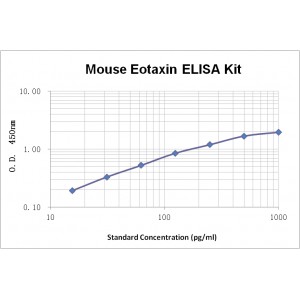More info
Assay Range | 15.6--1000 pg/mL |
Sensitivity | 1.0 pg/mL |
Specificity | No cross-reaction with other related substances detected |
Size | 96T |
Storage | Store at 2 - 8ºC. Keep reconstituted standard and detection Ab at -20 ºC |
Assay Principle | Sandwich ELISA |
Sample Volume | 100 µL final volume, dilution factor varies on samples |
Sample Type | serum, plasma or cell culture supernatant |
Detection Method | Chromogenic |
Kit Components
1. Recombinant Mouse Eotaxin standard: 2 vials
2. One 96-well plate coated with Mouse Eotaxin Ab
3. Sample diluent buffer: 12 mL - 1
4. Detection antibody: 130 µL, dilution 1:100
5. Streptavidin-HRP: 130 µL, dilution 1:100
6. Antibody diluent buffer: 12 mL x1
7. Streptavidin-HRP diluent buffer: 12 mL x1
8. TMB developing agent: 10 mL x1
9. Stop solution: 10 mL x1
10. Washing solution (20x): 25 mL x1
Background
C-C motif chemokine 11, also known as eosinophil chemotactic protein, small-inducible cytokine A11 and eotaxin-1, is a small cytokine belonging to the CC chemokine family. The mature human CCL11 is a 74 amino acid protein derived from the 97 amino acid CCL11 precursor protein by proteolytically removing the N-terminal 23 amino acid signal peptide. The mature human CCL11 shares 60% sequence identity to mature mouse CCL11. CCL11 binds to the G-protein-linked receptors CCR2, CCR3 and CCR5 to activate a series of cellular processes. Importantly, CCR3 is a highly specific receptor of CCL11. Human CCL11 is chemotactic for eosinophils, but not mononuclear cells or neutrophils which do not express CCR3. Increased levels of CCL11 in blood plasma have been implicated in aging in mice and humans. It has been demonstrated that exposing young mice to CCL11 or the blood plasma of older mice decreases their neurogenesis and cognitive performance on behavioural tasks. It is reported that CCL11 might be involved in eosinophilic inflammatory diseases such as atopic dermatitis, allergic rhinitis, asthma and parasitic infections.


